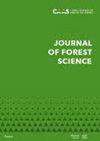利用Sentinel-2卫星图像确定叙利亚的烧伤面积以及火灾对土壤养分可用性的影响
IF 1.1
Q3 FORESTRY
引用次数: 2
摘要
本研究的目的是确定2020年9月2日至10月15日在叙利亚发生的烧毁森林地区。使用Sentinel-2图像确定森林火灾风险等级。采用归一化燃烧比(NBR)、差异归一化燃烧比(dNBR)、Sentinel-2的烧毁面积指数(BAIS2)和归一化植被指数(NDVI)来识别森林的破坏程度并建立火灾风险等级。根据研究结果,确定了因火灾而被破坏的植被面积大小,并建立了这些区域的森林火灾暴露概率。在燃烧过程中,大火还改变了土壤中的一些化学性质。因此,本研究的重点是火灾对土壤养分有效性的影响。在火灾发生一个月后,在Al-Fazeen、Sawda和Gard Al-rihan三个地点的林地下三个深度(0-10厘米、10-20厘米和20-30厘米)采集了土壤样本。松树(Pinus brutia)覆盖了这些地区。结果表明:与未燃烧的土壤相比,3个地点土壤中微量元素Zn、Cu、Mn、Fe的溶解度有所增加,有机质含量和粉土比均有所下降,土壤有机质含量和粉土比均有所下降。本文章由计算机程序翻译,如有差异,请以英文原文为准。
Burned area determination using Sentinel-2 satellite images and the impact of fire on the availability of soil nutrients in Syria
The objective of this research is the identification of burned forest areas that occurred in Syria from September 2nd to October 15th, 2020. Forest fire risk classes were determined using Sentinel-2 images. Normalized Burn Ratio (NBR), Differenced Normalized Burn Ratio (dNBR), and Burned Area Index for Sentinel-2 (BAIS2), and Normalized Difference Vegetation Index (NDVI) were used for the identification how much the forests have been destroyed and to establish fire risk classes. According to the study results, the size of the vegetation area that was destroyed due to fire was determined, and the probability of the forest fire exposure of these areas was established. The fires also altered some chemical properties in the soil during the combustion process. Thus, this study was focused on the impact of fire on the availability of soil nutrients. Soil samples were collected from three depths (0–10 cm, 10–20 cm and 20–30 cm) under the forest land a month after the fire in three locations: Al-Fazeen, Sawda and Gard Al-rihan. Pine (Pinus brutia) trees cover these areas. The results of this study indicated that the fire increased pH, EC and sand, the fire also led to an increase in the solubility of the available major soil elements N, P and K. There was an increase in the solubility of the soil microelements Zn, Cu, Mn and Fe while the content of organic material and silt and clay ratio decreased at the three sites in comparison with unburned soil.
求助全文
通过发布文献求助,成功后即可免费获取论文全文。
去求助
来源期刊

Journal of forest science
Forestry-
CiteScore
2.30
自引率
9.10%
发文量
48
审稿时长
6 weeks
期刊介绍:
Original results of basic and applied research from all fields of forestry related to European forest ecosystems and their functions including those in the landscape and wood production chain are published in original scientific papers, short communications and review articles. Papers are published in English
 求助内容:
求助内容: 应助结果提醒方式:
应助结果提醒方式:


